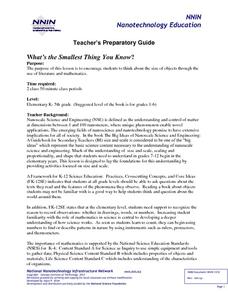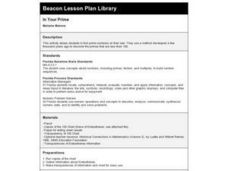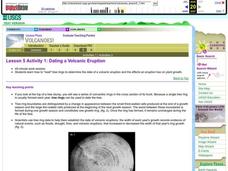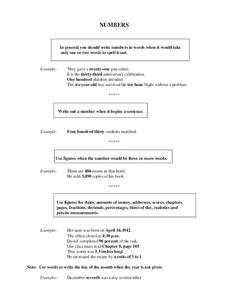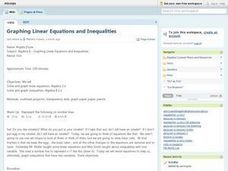Curated OER
Geometry Project
Proofs are usually an intimidating assignment. An engaging lesson focused on geometric proofs may reduce the anxiety! Pupils choose between several triangle proofs to complete and work on completing them. The...
National Nanotechnology Infrastructure Network
What’s the Smallest Thing You Know?
Elementary learners listen to a story, then sort objects from largest to smallest at six different stations around the classroom. Adaptable for a large range of age and ability groups.
College Board
Is That an Assumption or a Condition?
Don't assume your pupils understand assumptions. A teacher resource provides valuable information on inferences, assumptions, and conditions, and how scholars tend to overlook these aspects. It focuses on regression analysis, statistical...
US Apple Association
Apples: A Class Act! (Grades Pre-K–3)
Discover the nutritional wonders of apples and get to know Johnny Appleseed with a plethora of learning experiences that cover subjects math, history, English language arts, health, and arts and crafts. Activities include an apple...
Curated OER
Plotting a Hurricane Using Latitude and Longitude
Learners define and use "absolute location," latitude, and longitude. They locate on a map or globe the Earth's poles, circles, tropics, and beginning points of measurements for latitude and longitude.
Visa
A Way to Wealth: Understanding Interest and Investments
Money motivates! Help young bankers understand how math plays a part in investing. Give learners math practice while instilling real-world financial literacy skills.
Curated OER
In Your Prime
Students study how to find prime numbers. They investigate the teachings of the mathematician Eratosthenes and apply his theory of prime numbers less than 100.
Curated OER
Pythagorean Theorem
Students engage in a study of the Pythagorean Theorem to classify the hypotenuse of a triangle. The teacher uses examples from the lesson to aid students in comprehension of solving problems that involve problem solving. They create a...
Curated OER
What is Your Favorite Number?: Graph
In this favorite number graph worksheet, students will ask their classmates which number they like the best and record responses to complete the bar graph. Students can choose numbers 1 to 9.
Curated OER
Using a Calendar
Students explore a calendar. In this calendar activity, students sequence the 12 months of the year using posters with guidance from the teacher. Students recite the days of the week.
Curated OER
Measure
Students are asked what activities or things that they do each day. They are then asked do you do that in the morning, afternoon, or night? Students are then asked which of those things do you do first, second, third, and etc.
Curated OER
Geometry Straws
Students create different angles and shapes by using different lengths of straws. In this geometry straws lesson plan, students glue straws onto paper and define what they have made.
Curated OER
Who Has...?
In this Algebra I worksheet, 9th graders represent verbal expression algebraically and evaluate the expressions for the given replacement values of the variables. The three page worksheet contains the instructions for the card game and...
Curated OER
Problem Solving---A Part of Everyday Thinking
Students demonstrate knowledge of the six basic steps to problem solving. They demonstrate ability to apply these six basic steps to problem solving by guiding other students in the solution of a given problem or set of problems.
Curated OER
Ricks Bed
In this secondary mathematics worksheet, high schoolers solve a problem in which Rick is paid so much for each day his bed is made and is fined a certain amount for each day it is left unmade to determine the number of days he failed to...
Curated OER
Applied Science - Science and Math Pre - Lab (Scientific Method)
Students examine science. In this scientific method lesson, students are introduced to what every experiment contains (hypothesis, critical thinking) and how an experiment is conducted. They watch a demonstration and then work...
Curated OER
Math -- Money
Students identify a penny, nickel, dime, quarter and a half dollar. They examine the value of each coin and its equivalents (to quarter/dollar). After pairing up with a classmate, each one drills the other one on each coin.
Curated OER
Dating a Volcanic Eruption
Young scholars discover how to "read" tree rings to determine the date of a volcanic eruption and the effects an eruption has on plant growth. After a lecture/demo, students utilize a worksheet imbedded in this plan to date an eruption.
National External Diploma Program Council
Numbers
The written form for 345 is three-hundred forty-five, where as the word form for 70% is seventy percent. Here, young mathematicians read 10 sentences and write the word form of each number in the sentences.
Curated OER
Right on Time
The hour is nigh for your class to practice equivalency problems in the form of time-zone conversions. They write equations to describe elapsed time and apply problem solving strategies, including writing a plan, to solve the problems.
Curated OER
"Weighing the Elephant"
Can your class solve the problem presented in the Chinese folktale, "Weighing the Elephant?" Read your class the description before having them attempt to solve the problem. After they've come up with an answer (or attempted to!), finish...
Curated OER
Graphing the Population Explosion of Weeds
Students are introduced to the seed cycle and draw the specific steps. In groups, they identify the human barriers to the spreading of weeds. After calculating the rate of spreading of the Yellowstar Thistle, they create graphs to see a...
Curated OER
Graphing Linear Equations and Inequalities
Students discuss methods to solve equations and inequalities with one variable. As a review, they write Addition and Subtraction properties of equality and Multiplication and Division properties of equality. Students graph points, write...
Curated OER
Your Next Class Trip
Investigate the techniques used in a persuasive argument. Young writers compose a persuasive argument persuading their principal to take their class on a trip to the location of their choice. They then create a persuasive web site.

